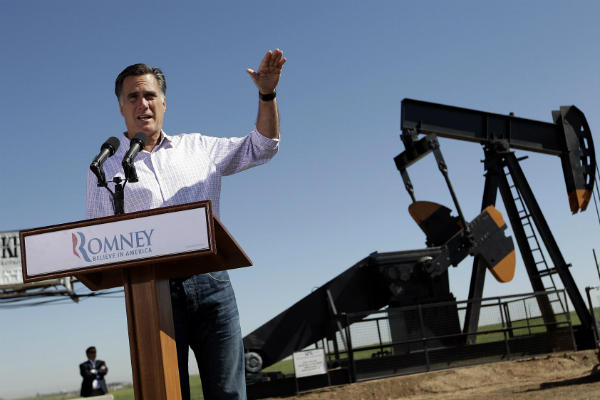Republican presidential candidate Mitt Romney recently unveiled his energy plans for the United States, which promises to fulfill the country’s four-decades’-old dream of energy independence. It has the potential to do so. But the price could ultimately be high: a breakdown in global climate negotiations and a rift in relations with Europe.
American and European energy markets are on a diverging path. The US has edged closer to self-sufficiency with respect to fossil fuels, due mostly to the extensive development of its unconventional resources. From 60 percent in 2005, net petroleum imports were down to 45 percent of the US supply last year. By 2020, this rate could be further reduced close to zero, excluding Canada and Mexico. Shale gas made the United States the number one natural gas producer in the world, overtaking Russia, and revitalized manufacturing and the chemical industry.
Meanwhile, climate-conscious Europe’s already high energy import dependence continues to grow. Use of renewable resources mandated by the European Union are spreading dynamically, but will take time to mature. Indigenous unconventional gas faces mixed reactions in some member states. In the wake of the Fukushima accident, nuclear energy is on decline in most countries. Ironically, coal use has increased lately in Germany, due to the nuclear power plant closures and flaws in the EU’s cap-and-trade system.
Romney has proposed a plan that would widen the transatlantic gap further. He proposes to accelerate the development of America’s considerable on- and offshore oil and natural resources by opening up federal lands and wildlife refuges, relaxing legislation, extending tax breaks, and approving Keystone XL that would carry shale oil from Canada; to rehabilitate coal by reverting the Environmental Protection Agency’s prohibitive clean air standards introduced by the current administration; and to revitalize nuclear power by streamlining the permitting procedures.
The underlying tenet of the plan is a complete disregard for the threat of climate change, a term the document does not use. Romney renounces the “myth of green jobs creation” and promotes new jobs in the oil, gas, and coal sectors instead. The plan also stipulates that renewables can compete with other resources on a “level playing field,” and implies the cessation of government support for renewable energy projects.
The plan, not to mention its implementation, will cause outrage in Europe. To most European policymakers, and the general public alike, shale oil and coal are anathemas, and the “drill baby drill” mentality is considered environmentally reckless. Brussels and other European capitals already resent that President Obama has not spent enough political capital on global climate change negotiations. Europeans worry that a Romney administration would derail the timeframe agreed to in Cancun last December.
Moreover, Europeans believe that a pursuit of US energy independence could prove both elusive and counter-productive. Even if complete self-sufficiency is achieved, oil prices are determined on the global oil market. The United States might miss breakthroughs in technologies and business opportunities that are offered by the global scramble for renewables. While global challenges to stable energy markets prevail, an illusion of energy independence might prompt a more isolationist stance in US foreign policy and a reduced commitment to strategic interests like Europe’s energy security.
A transatlantic friction is looming. Would the United States and Europe ultimately be able to reconcile their visions? The transatlantic partners share strategic interests and face common threats and challenges closely linked to energy issues, such as the proliferation of nuclear weapons, a resurgent Russia, an unstable Middle East, or China’s insatiable appetite for resources and its repercussions around the globe. The United States and Europe are uniquely positioned to develop technology, leverage financing, and share experiences in legislative and regulatory developments. In times of austerity, identifying synergies and pooling resources is paramount.
There is also plenty to build upon. Owed largely to the increased use of cheap natural gas in electricity generation, to the detriment of coal and measures like enhanced vehicle fuel economy standards, last week the US Energy Information Administration reported that energy-related CO2 emissions in the first three months of the year were the lowest since 1992 (though still much higher per capita than in Europe). While Congress and the US government are paralyzed, more than thirty US states adopted renewable energy portfolio standards similar to the EU’s 20 percent target by 2020. Regional emission trading schemes are on the rise in the absence of a federal one. Texas is becoming a renewable energy technology hotspot and wind and solar powerhouse. Many in Europe are willing to learn from the US how to unlock their own shale gas potential that can serve as a bridge fuel to the EU’s preferred zero-carbon future as gas emits much less CO2. Conversely, the US is looking to exploit four decades of European experience in energy efficiency improvements and demand reduction. Though politically and financially tricky, both EU member states and the United States should revisit nuclear energy as an essential component in providing affordable and sustainable energy. The list goes on.
The benefits of transatlantic cooperation are beyond doubt. The consequences of a falling out between the United States and the EU after the elections would be far-reaching. A continued dialogue launched in the framework of the US-EU Energy Council in 2009 would be a way to avoid that. Joint efforts to address climate change, innovation, and investment in clean energy technologies, risk sharing, and cost reduction; joint research and development and harmonized energy diplomacy should be the cornerstones. A value gap that will undermine trust within the alliance is in nobody’s interest.
David Koranyi is the deputy director of the Atlantic Council’s Dinu Patriciu Eurasia Center and the editor of the book Transatlantic Energy Futures – Strategic Perspectives on Energy Security, Climate Change and New Technologies in Europe and the United States published by the Johns Hopkins University SAIS Center for Transatlantic Relations in December, 2011
Image: romney%20oil.jpg

